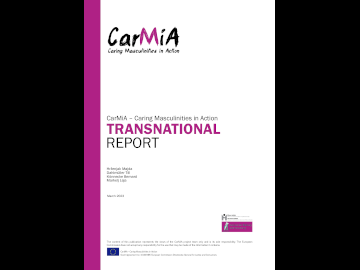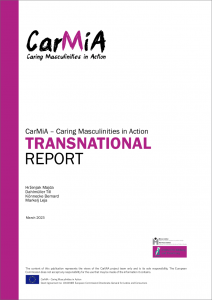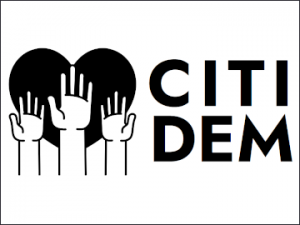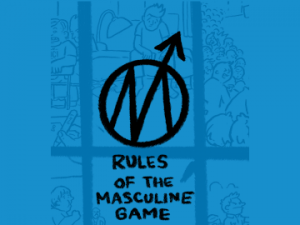Activating non-violent masculinities with young people
29. 3. 2023 | Gender

 Gender-based violence (GBV) is violence directed against a person because of his or her gender, or violence that disproportionately affects persons of a particular gender. It may be expressed as physical, sexual, psychological or economic violence. In today’s social gender order, GBV has two main functions: men*’s violence against women* is a mechanism to consolidate and maintain male superiority over women*; violence against other men* is a mechanism to enforce hierarchy among men*. The Caring Masculinities in Action – CarMiA project starts from the point of view that traditional gender socialization lies behind men*’s violence within a triad that also includes violence towards other men* and against themselves. Therefore an important part of promoting a culture of non-violence in the intimate and public spheres is awareness rising about the costs of patriarchy for boys* and men* too.
Gender-based violence (GBV) is violence directed against a person because of his or her gender, or violence that disproportionately affects persons of a particular gender. It may be expressed as physical, sexual, psychological or economic violence. In today’s social gender order, GBV has two main functions: men*’s violence against women* is a mechanism to consolidate and maintain male superiority over women*; violence against other men* is a mechanism to enforce hierarchy among men*. The Caring Masculinities in Action – CarMiA project starts from the point of view that traditional gender socialization lies behind men*’s violence within a triad that also includes violence towards other men* and against themselves. Therefore an important part of promoting a culture of non-violence in the intimate and public spheres is awareness rising about the costs of patriarchy for boys* and men* too.
Within the CarMiA project consultations with young people and experts about gender socialisation of boys* and GBV, and a review of good practices in GBV prevention were conducted in six European countries (Austria, Bulgaria, Germany, Italy, Slovenia and Spain).
The main findings are:
Consultations with young people revealed polarised attitudes towards masculinity, GBV and gender equality. Boys* who assertively expressed traditional views on masculinity and gender roles argue that boys* need to be tough, dominant, show invulnerability, ‘protect women’, and fight each other if necessary. On the other hand, there are egalitarian boys* who advocate gender equality and respect for diversity between people, expressing their vulnerability and resolving conflicts through constructive discussion. They described the demands on boys* and men* to restrict emotions, and to (always) show themselves strong, as the ‘biggest problem of masculinity’, which creates a vicious circle: being strong and not showing weakness creates fear, which in turn cannot be expressed. Boys* and men* would often compensate for this with violence.
Gender reflexive boys* see the tendency towards a higher incidence of violence among men* compared to women* because they are less able to recognize, articulate and non-violently process their vulnerabilities, emotionality, especially feelings of fear, stress or pressure and/or their own experiences of violence. Low self-esteem can increase the risk of violent behavior, as can recurring experiences of powerlessness due to racism, classism or structural violence in school and family
Young people anticipate relational gender dynamics. Although peer opinion is very important among boys*, in their doing masculinity they also respond to girls*’ stereotypes about what a ‘real man*’ should be.
As with the girls, the body is one of the central topics with boys* too, especially its size, strength and appearance. The group dynamics within the boys*’ groups revealed the domination of boys* who embodied the social norms of how a male body should look and act like.
Due to the absence of sex education at school, for boys* access to knowledge about sexuality is limited to friends and pornography on the internet, often at an early age, between ten and twelve.
Gender plurality and exploring non-binary gender identities is a hot topic among youngsters. Although many young people experience it as a fashion trend, in more progressive environments gender inclusivity and in particular inclusive masculinity can be observed.
Experts draw attention to the diversity of GBV stemming from traditional concepts of masculinity that range from physical and verbal violence to homophobia, transphobia, racism, sexism, material violence, on-line violence, bullying, and hate speech.
According to professionals, rigid masculinity norms are often salient in groups of marginalized young people from conservative, migrant or religious backgrounds where they are strongly related to national identity, faith, and traditional gender roles.
A review of preventive practices shows that systematically and in the long run the state does not fund preventive programmes explicitly addressing the social construction of masculinity in relation to GBV in any of the countries involved. Although a rich pool of pedagogical tools for gender-sensitive violence prevention exists, there is no source with an overview of existing materials neither at a national nor at the EU level.
The pedagogical approach, in the CarMiA project coined as norm critique & resource strengthening, seems to be very much needed. While norm critique encourages young people to (self)reflect masculinity, gender and other power relations (racism, classism, etc.), resource orientation provides empowerment of their potential for acting beyond gender stereotypes and for nonviolent behavior. The visibility of alternative masculinities that can be experienced in one’s environment and makes the diversity of masculinities tangible also seems very important to encourage young (male) people to question traditional, repressive concepts of masculinity, which offer a fertile ground for violent behavior. It is crucial to start implementing systemic solutions in the field of gender-reflective pedagogical work with boys* that would grasp the complexity of the field and establish continuous and sustainable actions to combat GBV.




